Archived Storm Damage Blog Posts
What to do When Returning Home after a Storm.
11/29/2022 (Permalink)
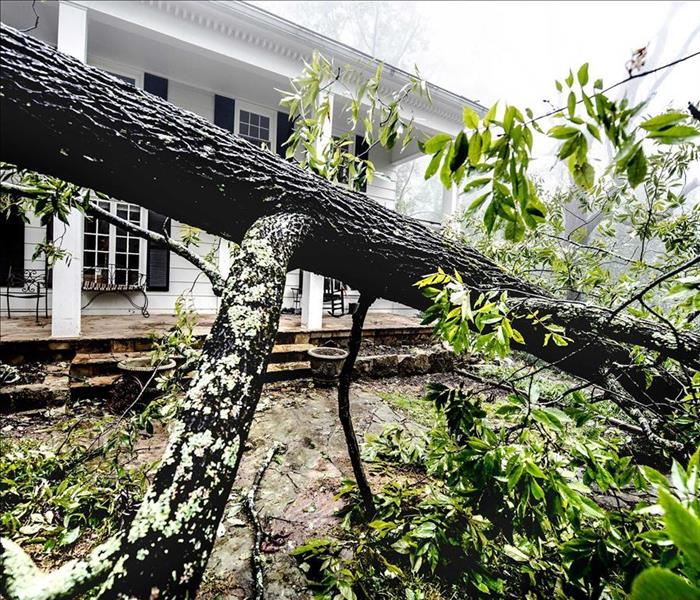
When storms send floodwater into your Tate, Tunica & Southwest DeSoto county home, you don't always know what to do. When is it safe to return to your house? Can you start the cleanup on your own? How you handle a flood will depend on the severity of the damage. It can be helpful to call about storm damage services right after the storm has left your area. You should also try to avoid doing the following:
1. Walking Into Standing Water
Did you know that 6 inches of moving water can cause you to lose your footing? Because even shallow waters can be dangerous, you should avoid walking into any standing water. Your flooded home may be full of stagnant water, but you should still avoid going into it. If the electricity is on, the water could be charged. Stormwater could contain dangerous contaminants, too.
2. Waiting To Schedule a Cleanup
Do you want to try to tackle the water damage on your own? Unless you know how to effectively remove flooding and humidity from your house, you should turn to a professional. The sooner you can schedule your cleanup, the better it will be for your home. If you wait too long, you may have increased mold growth in your space.
3. Returning to Your Home Too Soon
While you want your life to return to normal, you need to make sure the flood water is completely gone before you return. Going home too soon can make it harder for the cleanup crew to properly remove excess humidity. The cleanup may require building materials to be replaced, which can leave your home dusty. If you wait until the entire process is finished, you can return to a more normal life right when you move back in.
Storm flood water may cause you to leave your home until the damage can be fixed. Taking the wrong steps after this type of flood can make the restoration process harder than it has to be, so remember what not to do. You can find more detailed information from Ready.gov.
Do you know if you are in a Flood Zone?
9/20/2022 (Permalink)
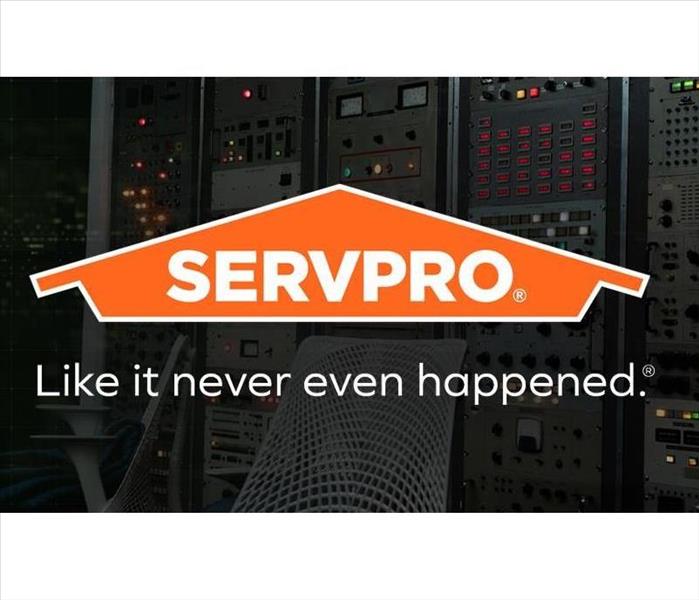 "Like it never even happened."
"Like it never even happened."
Do you live in a potential flood risk zone? If you don’t know the answer to that very important question. It allows you to easily enter your business, home, or other address to determine if your property is at risk for flooding based on a visual flood map. If you happen to live in a flood risk zone and your residential or commercial property is hit with flood damage, we can come to your rescue and make the damage “Like it never even happened.”
With more than 1,700 franchises strategically positioned throughout the U.S. and Canada, help is near when you experience flooding at your home or business.
No job is ever too big or too small for our team here at SERVPRO. Our heroes have helped rescue the day at a number of storm emergencies, such as Hurricane Ida, and many others. We can do the same for you should you ever experience such an event.
Call your local SERVPRO today!
SERVPRO of DeSoto, Tate & Tunica Counties
662-349-6500
"Like it never even happened."
Tips for Cleaning Your Crawlspace After a Flood
9/14/2022 (Permalink)
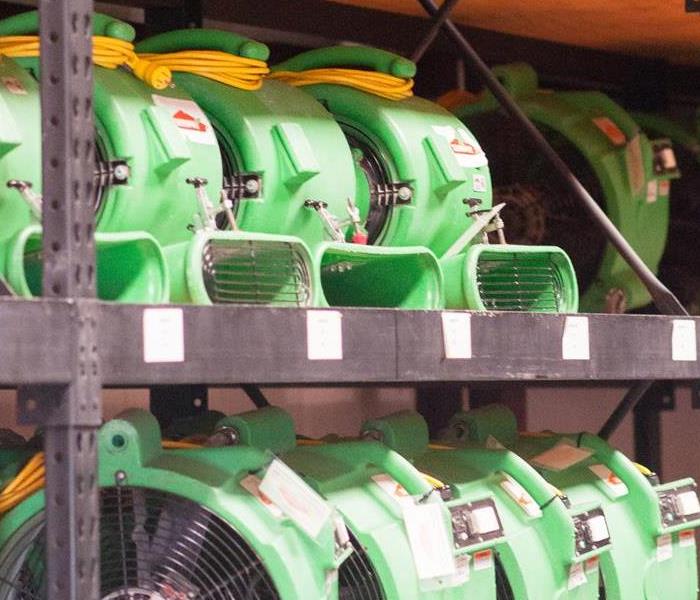 Call your local SERVPRO Today!
Call your local SERVPRO Today!
A home flood can occur any time there is a storm. While there are things you can do to protect your home during storm season, floodwater may still get in. It’s important to mitigate the damage not only in the spaces you can see but also in the spaces that are not readily visible. You should always check your crawlspace for flooding after heavy rain.
Appropriate Safety Precautions
There are several safety precautions to take when you know your home has storm damage. Anyone who enters standing water should wear proper protective gear:
• Rubber boots
• Heavy gloves
• Face mask
• Protective coveralls
You should also turn off the electricity to reduce the risk of shock. Use good judgment -- if you think any part of your home may be unsafe, stay elsewhere. Leave wading through floodwater in your crawlspace to the technicians from the flood restoration company that you hire to mitigate the damage.
Accurate Documentation
You should report your home flood to your insurance company, but an adjuster may not be able to make it to your house quickly if there are a lot of problems in the area due to the storm. To capture the most accurate evidence of the damage, it’s a good idea to take pictures or videos of the flood’s impact on the crawlspace and other affected areas. This can be valuable when you are filing your claim.
Thorough Cleanup
Ideally, your sump pump will kick in when the water in your crawlspace starts to rise, so that should take care of a lot of the major extraction. The area must be completely dried and disinfected before the job is done, though. A thorough cleanup helps prevent mold growth and the subsequent damage it can cause to the structure of your home.
Home flood cleanup must cover both the areas you can see and those you cannot see. Don’t forget spaces such as your crawlspace when assessing the damage.
The Dangers of Thunderstorms- What You Need to Know
8/4/2022 (Permalink)
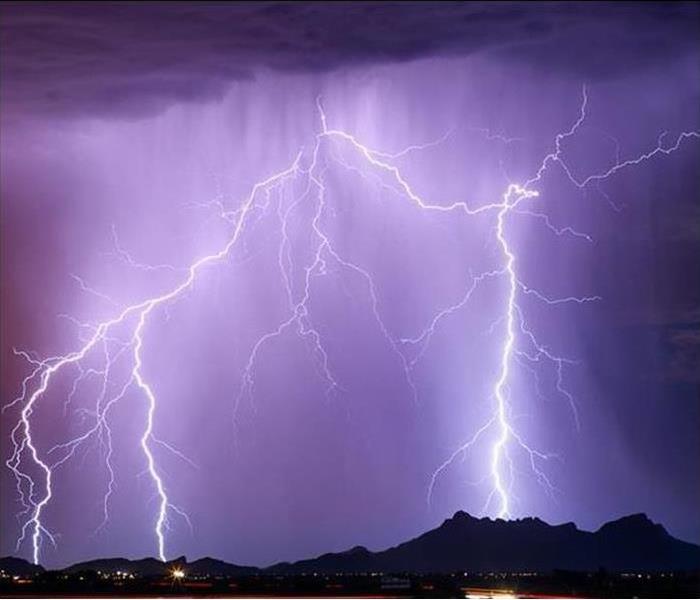 If you have damage due to a thunderstorm, contact SERVPRO!
If you have damage due to a thunderstorm, contact SERVPRO!
At SERVPRO, we understand severe weather can be stressful. Always be prepared ahead of the storm, and be sure to have alerts set up.
When you think of severe weather, tornadoes may quickly come to mind. There’s a good reason for that. While these storms are most common during the spring, they can occur at any point in our warm, humid conditions.
But while tornadoes are a weather danger to keep in mind, it’s also a good idea to pay attention to thunderstorms.
Thunderstorms are defined as any storm that involves thunder. These storms are so common we often disregard them. But high winds, lightning, hail, flooding, and other issues involved in thunderstorms can quickly turn dangerous. A thunderstorm moves into the severe category when it contains hail that is one inch or larger and straight-line winds of 58 miles per hour or more. Here is what you should know about potential thunderstorm hazards:
Damage and injury from lightning strikes. You now know that thunderstorms always involve thunder. But did you know they also always have lightning? That’s because thunder and lightning are always paired together; you won’t have one without the other, even if lightning isn’t visible. Lightning strikes cause around 300 injuries every year, and they can also contribute to property damage both from direct contact with lightning and indirect effects such as fallen trees.
Harm from flash flooding. Flash floods can occur any time there is heavy rain for a plethora of reasons—even if storm drains back up or small ditches become filled with water, heavy rain can quickly turn these things into a life-threatening flooding scenario. This presents a particular danger on the roads. If flash flood conditions are possible, it’s best to stay at home.
Property damage due to hail. When it comes to hail, there are two factors to consider: the size of the hail and the force with which it falls. These ice pellets can range in size from tiny to very large, and the bigger they are, the more dangerous they are. In severe thunderstorms, where hail is larger, pellets can propel with some force on your roof, which can cause leaks and water damage.
Thunderstorms are dangerous and can cause significant damage to homes or commercial spaces. If you have damage due to a thunderstorm, contact SERVPRO!
Has a Storm Damaged The Basement of Your Home? 4 Steps to Take When Your Home Basement Is Flooded
8/1/2022 (Permalink)
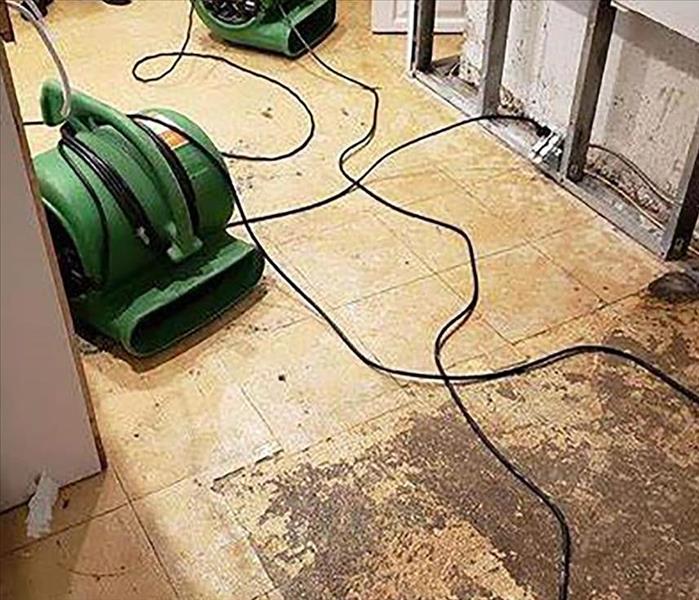 Call your local SERVPRO today!
662-349-6500
Call your local SERVPRO today!
662-349-6500
How to Deal With a Flooded Basement
Unfortunately, many homeowners have experienced a basement flood at one time or another. If you have standing water down there, it is vital to know how to deal with it. Before you begin the cleanup process, follow these steps.
1. Shut Off the Electricity
Before anything else, you want to shut off the electricity and power to the basement. Not doing so could lead to injuries, so take every precaution possible. If you are unsure of how to do this, it is best to call a water damage specialist.
2. Find the Source
If the basement flood was caused by rainfall, you can go ahead and begin the cleanup process. Otherwise, you need to find the source. To prevent any more contamination to the area, you should shut off the water. Once you have located the cause, you either need to fix it yourself or call a professional to come help.
3. Remove the Water
Getting rid of the water can take time. What you use depends on how badly the room was flooded. Sump pumps or pool pumps can be effective. If there is only a small amount of liquid on the ground, you may even be able to use a mop.
4. Call Your Insurance Company
You want to check on what type of insurance coverage you have after an ordeal like this. Oftentimes the company is more likely to pay if the problem is treated quickly and was not caused by negligence on your part. Using a trusted business to help with the cleanup may also help you get a better payout.
It is important to remember that a basement flood can be extremely dangerous. Take the utmost care when handling the damage yourself. If you feel at all uncomfortable or unsafe, call SERVPRO!
Storm Preparedness
4/14/2022 (Permalink)
Here are some tips that we believe will be helpful in preparing for severe weather.
TORNADOES
Tornadoes can strike without warning and destroy a community in seconds. Before a tornado warning is issued for your area, here are some things you should do:
1. Know your community’s warning system.
2. Pick a place where family members can gather if a tornado is headed your way. It could be your basement or, if there is no basement, a center hallway, bathroom, or closet on the lowest floor. Keep this place uncluttered.
3. If you are in a high-rise building and don’t have enough time to go to the lowest floor, pick a place in a hallway in the center of the building.
4. Remove diseased and damaged limbs from trees.
5. Move or secure lawn furniture, trash cans, hanging plants or anything else that can be picked up by the wind and become a projectile.
THUNDERSTORM SAFETY STEPS Thunderstorms injure an average of 300 people every year, and cause about 80 fatalities. Here are the top thunderstorm safety steps you should follow:
1. If you can hear thunder, you are close enough to the storm to be struck by lightning. Go to safe shelter immediately.
2. As the storm approaches, take shelter in a building.
3. If you are driving, pull off the roadway and park. Stay in the car with the windows closed and turn on the emergency flashers. Avoid touching metal or other surfaces that conduct electricity in and outside of the vehicle.
4. If you are inside, unplug appliances and avoid using the telephone or any electrical appliances. Avoid taking a bath or shower, or running water for any other purpose.
5. If you are caught outside and cannot reach a safe building, avoid high ground, water, tall, isolated trees and metal objects such as fences or bleachers. Picnic shelters, dugouts and sheds are not safe.
FLOODING Heavy rains could fill rivers and streams, bringing flooding to the area. If your neighborhood is threatened with the possibility of flooding, here are some things you should do:
1. Be prepared to evacuate at a moment’s notice. When a flood or flash flood warning is issued for your area, head for higher ground and stay there.
2. Stay away from floodwaters.
3. If you come upon a flooded road while driving, turn around and go another way. If you are caught on a flooded road and waters are rising rapidly around you, get out of the car quickly and move to higher ground. Most cars can be swept away by less than two feet of moving water.
4. Keep children out of the water.
5. Be especially cautious at night when it is harder to recognize flood danger.
SERVPRO of DeSoto, Tate and Tunica Counties is always here to help! Should you need help after severe weather please give us a call at 662-349-6500.
When Storms Hit Southaven
11/12/2021 (Permalink)
SERVPRO of Desoto, Tate, & Tunica Counties specialize in storm and flood damage restoration. Our crews are highly trained and we use specialized equipment to restore your property to its pre-storm condition.
Since we are locally owned and operated, we are able to respond quicker with the right resources, which is extremely important. A fast response lessens the damage, limits further damage, and reduces restoration costs.
When storms hit Southaven, MS and surrounding towns we can scale our resources to handle a large storm or flooding disaster. We can access equipment and personnel from a network of 1,650 franchises across the country and elite Disaster Recovery Teams that are strategically located throughout the United States.
Have STORM or FLOOD DAMAGE? Call SERVPRO of DeSoto, Tate and Tunica counties today at (662) 349-6500!
Severe Weather Preparedness
2/1/2021 (Permalink)
Here are some tips that we believe will be helpful in preparing for severe weather.
TORNADOES
Tornadoes can strike without warning and destroy a community in seconds. Before a tornado warning is issued for your area, here are some things you should do:
1. Know your community’s warning system.
2. Pick a place where family members can gather if a tornado is headed your way. It could be your basement or, if there is no basement, a center hallway, bathroom, or closet on the lowest floor. Keep this place uncluttered.
3. If you are in a high-rise building and don’t have enough time to go to the lowest floor, pick a place in a hallway in the center of the building.
4. Remove diseased and damaged limbs from trees.
5. Move or secure lawn furniture, trash cans, hanging plants or anything else that can be picked up by the wind and become a projectile.
THUNDERSTORM SAFETY STEPS Thunderstorms injure an average of 300 people every year, and cause about 80 fatalities. Here are the top thunderstorm safety steps you should follow:
1. If you can hear thunder, you are close enough to the storm to be struck by lightning. Go to safe shelter immediately.
2. As the storm approaches, take shelter in a building.
3. If you are driving, pull off the roadway and park. Stay in the car with the windows closed and turn on the emergency flashers. Avoid touching metal or other surfaces that conduct electricity in and outside of the vehicle.
4. If you are inside, unplug appliances and avoid using the telephone or any electrical appliances. Avoid taking a bath or shower, or running water for any other purpose.
5. If you are caught outside and cannot reach a safe building, avoid high ground, water, tall, isolated trees and metal objects such as fences or bleachers. Picnic shelters, dugouts and sheds are not safe.
FLOODING Heavy rains could fill rivers and streams, bringing flooding to the area. If your neighborhood is threatened with the possibility of flooding, here are some things you should do:
1. Be prepared to evacuate at a moment’s notice. When a flood or flash flood warning is issued for your area, head for higher ground and stay there.
2. Stay away from floodwaters.
3. If you come upon a flooded road while driving, turn around and go another way. If you are caught on a flooded road and waters are rising rapidly around you, get out of the car quickly and move to higher ground. Most cars can be swept away by less than two feet of moving water.
4. Keep children out of the water.
5. Be especially cautious at night when it is harder to recognize flood danger.
SERVPRO of DeSoto, Tate and Tunica Counties is always here to help! Should you need help after severe weather please give us a call at 662-349-6500.
Being disaster ready
2/1/2021 (Permalink)
In order to be fully prepared, you should have all pertinent and proper information in a written plan for east retrieval. Some key questions to consider when creating a person preparedness plan include:
- Do you have an escape or evacuation route in place?
- Do you have a designated meeting place in case of separation?
- Does everyone have a list of contact information including family members out of state who can serve as a point of contact?
- Do you have a disaster supply kit with necessary supplies?
- Do you have a first aid kit that includes necessary prescription medicines, over-the-counter medicines and basic medical supplies?
- Do you have enough non-perishable food and bottled water?
- Do you have access to important family documents, including insurance policies, bank, credit card, and loan information and family records such as birth certificates and social security cards?
- Do you have an inventory of valuable household goods?
A well-equipped disaster supply kit should include, but is not limited to, the following,
- Water - a large enough supply to provide each person with 1 gallon daily for drinking and sanitation.
- Food - enough to last 3-7 days. Food needs to be non-perishable or canned food. You will also want to include a non-electric can opener, paper plates, and plastic utensils.
- Bedding including sheets, blankets, and pillows.
- Clothing - remember it may be warm, however, you may be working and cleaning and may prefer pants or long sleeves to protect your skin. You will also need sturdy, closed toe, non-slip shoes if available.
- First aid kit including antiseptics or sanitizers and bandages, over-the-counter and prescription medications.
- Extra flashlights and batteries. Oil lanterns also provide a good source of light, if available.
- Toiletries including toilet paper and hygiene items. Hand sanitizers are also good to have on hand.
- Battery-operated radio with extra batteries so you can listen to weather service announcements.
- Cash - you will want some cash and small bills on hand as banks may not be open.
- Emergency phone numbers and contact information including insurance agent and family contacts.
- Tools, tarps, plastic sheets, trash bags, duct tape, etc. to help make minor repairs.
- Important documents should be kept in a waterproof bag or plastic sealed container and should include insurance, medical and family records, birth certificates, social security cards, bank account information and a complete home inventory analysis.
- Gas - fill you car's tank ahead of time if time permits. You may also want to fill plastic gasoline-approved containers with gas to store.
- Pet care items including food, leash and a carrier or cage.
Don't wait until it is too late; prepare not to help protect your family in an emergency or disaster situation.
When the storm rolls out, we roll in
2/1/2021 (Permalink)
Unexpected emergencies like severe weather call for immediate action. SERVPRO of Tupelo knows immediate reaction to the disaster is important to helping you get your life back to normal.
Utilizing our 1-4-8 Service Response Guidelines we strive to:
- Contact you within 1 hour from notice of loss to arrange for your service.
- Be-on-site to begin mitigation services within 4 hours of notification.
- Provide verbal briefing of scope to you within 8 business hour of on-site arrival.
Exceptions to our 1-4-8 Service Response times may apply under certain conditions, such as a local catastrophic event or storm situation.
We also perform pack-out services, which is removing salvageable personal property from the affected area for off-site cleaning and storage.
If you have storm damage to your home or property, call us today 662-395-6500. Timely mitigation is the key to minimize secondary damages caused by severe storms. We are also a one stop shop. We can handle everything from tarping and board ups to all of your post construction needs as well.
Storm Damage Steps
10/13/2020 (Permalink)
Unexpected emergencies like severe weather call for immediate action. SERVPRO of DeSoto, Tate and Tunica counties knows immediate reaction to the disaster is important to helping you get your life back to normal.
Utilizing our 1-4-8 Service Response Guidelines we strive to:
- Contact you within 1 hour from notice of loss to arrange for your service.
- Be-on-site to begin mitigation services within 4 hours of notification.
- Provide verbal briefing of scope to you within 8 business hour of on-site arrival.
Exceptions to our 1-4-8 Service Response times may apply under certain conditions, such as a local catastrophic event or storm situation.
We also perform pack-out services, which is removing salvageable personal property from the affected area for off-site cleaning and storage.
If you have storm damage to your home or property, call us today at 662-395-6500. Timely mitigation is the key to minimize secondary damages caused by severe storms. We are also a one stop shop. We can handle everything from tarping and board ups to all of your post construction needs as well.
Severe Weather Preparedness
10/10/2019 (Permalink)
Here are some tips that we believe will be helpful in preparing for severe weather.
TORNADOES
Tornadoes can strike without warning and destroy a community in seconds. Before a tornado warning is issued for your area, here are some things you should do:
1. Know your community’s warning system.
2. Pick a place where family members can gather if a tornado is headed your way. It could be your basement or, if there is no basement, a center hallway, bathroom, or closet on the lowest floor. Keep this place uncluttered.
3. If you are in a high-rise building and don’t have enough time to go to the lowest floor, pick a place in a hallway in the center of the building.
4. Remove diseased and damaged limbs from trees.
5. Move or secure lawn furniture, trash cans, hanging plants or anything else that can be picked up by the wind and become a projectile.
THUNDERSTORM SAFETY STEPS Thunderstorms injure an average of 300 people every year, and cause about 80 fatalities. Here are the top thunderstorm safety steps you should follow:
1. If you can hear thunder, you are close enough to the storm to be struck by lightning. Go to safe shelter immediately.
2. As the storm approaches, take shelter in a building.
3. If you are driving, pull off the roadway and park. Stay in the car with the windows closed and turn on the emergency flashers. Avoid touching metal or other surfaces that conduct electricity in and outside of the vehicle.
4. If you are inside, unplug appliances and avoid using the telephone or any electrical appliances. Avoid taking a bath or shower, or running water for any other purpose.
5. If you are caught outside and cannot reach a safe building, avoid high ground, water, tall, isolated trees and metal objects such as fences or bleachers. Picnic shelters, dugouts and sheds are not safe.
FLOODING Heavy rains could fill rivers and streams, bringing flooding to the area. If your neighborhood is threatened with the possibility of flooding, here are some things you should do:
1. Be prepared to evacuate at a moment’s notice. When a flood or flash flood warning is issued for your area, head for higher ground and stay there.
2. Stay away from floodwaters.
3. If you come upon a flooded road while driving, turn around and go another way. If you are caught on a flooded road and waters are rising rapidly around you, get out of the car quickly and move to higher ground. Most cars can be swept away by less than two feet of moving water.
4. Keep children out of the water.
5. Be especially cautious at night when it is harder to recognize flood danger.
SERVPRO of DeSoto, Tate and Tunica Counties is always here to help! Should you need help after severe weather please give us a call at 662-349-6500.
Being Disaster Ready
10/8/2019 (Permalink)
In order to be fully prepared, you should have all pertinent and proper information in a written plan for east retrieval. Some key questions to consider when creating a person preparedness plan include:
- Do you have an escape or evacuation route in place?
- Do you have a designated meeting place in case of separation?
- Does everyone have a list of contact information including family members out of state who can serve as a point of contact?
- Do you have a disaster supply kit with necessary supplies?
- Do you have a first aid kit that includes necessary prescription medicines, over-the-counter medicines and basic medical supplies?
- Do you have enough non-perishable food and bottled water?
- Do you have access to important family documents, including insurance policies, bank, credit card, and loan information and family records such as birth certificates and social security cards?
- Do you have an inventory of valuable household goods?
A well-equipped disaster supply kit should include, but is not limited to, the following,
- Water - a large enough supply to provide each person with 1 gallon daily for drinking and sanitation.
- Food - enough to last 3-7 days. Food needs to be non-perishable or canned food. You will also want to include a non-electric can opener, paper plates, and plastic utensils.
- Bedding including sheets, blankets, and pillows.
- Clothing - remember it may be warm, however, you may be working and cleaning and may prefer pants or long sleeves to protect your skin. You will also need sturdy, closed toe, non-slip shoes if available.
- First aid kit including antiseptics or sanitizers and bandages, over-the-counter and prescription medications.
- Extra flashlights and batteries. Oil lanterns also provide a good source of light, if available.
- Toiletries including toilet paper and hygiene items. Hand sanitizers are also good to have on hand.
- Battery-operated radio with extra batteries so you can listen to weather service announcements.
- Cash - you will want some cash and small bills on hand as banks may not be open.
- Emergency phone numbers and contact information including insurance agent and family contacts.
- Tools, tarps, plastic sheets, trash bags, duct tape, etc. to help make minor repairs.
- Important documents should be kept in a waterproof bag or plastic sealed container and should include insurance, medical and family records, birth certificates, social security cards, bank account information and a complete home inventory analysis.
- Gas - fill you car's tank ahead of time if time permits. You may also want to fill plastic gasoline-approved containers with gas to store.
- Pet care items including food, leash and a carrier or cage.
Don't wait until it is too late; prepare not to help protect your family in an emergency or disaster situation.
Storm damage cleanup
9/16/2019 (Permalink)
Unexpected emergencies like severe weather call for immediate action. SERVPRO of DeSoto, Tate and Tunica counties knows immediate reaction to the disaster is important to helping you get your life back to normal.
Utilizing our 1-4-8 Service Response Guidelines we strive to:
- Contact you within 1 hour from notice of loss to arrange for your service.
- Be-on-site to begin mitigation services within 4 hours of notification.
- Provide verbal briefing of scope to you within 8 business hour of on-site arrival.
Exceptions to our 1-4-8 Service Response times may apply under certain conditions, such as a local catastrophic event or storm situation.
We also perform pack-out services, which is removing salvageable personal property from the affected area for off-site cleaning and storage.
If you have storm damage to your home or property, call us today at 662-395-6500. Timely mitigation is the key to minimize secondary damages caused by severe storms. We are also a one stop shop. We can handle everything from tarping and board ups to all of your post construction needs as well.
Floods happen in Southaven too!
9/16/2019 (Permalink)
Floods rank as one of the most common widespread natural disasters in the United States. Whether you live near a coastline, along city streets, in the mountains, near a river, or even in the desert, there is a potential for suffering flood damage. In fact, nearly 25% of last year's claims paid by the National Flood Insurance Program were for policies in moderate to low-risk communities. According to NFIP, houses in the United States have a 26% chance of being damaged by a flood during the course of a 30 year mortgage, while businesses face similar risks by flooding. On average, floods cost $6 billion in annual losses in the U.S. The following are a few more little-known flood facts:
- Floods kill an average of 140 people per year in the U.S., making flooding the most deadly natural disaster.
- More than half of the fatalities during floods are auto related, often the result of drivers misjudging the depth of water on a road and being swept away in a swiftly moving current.
- The principle causes of floods in the eastern United States are hurricanes and storms.
- The principle causes of floods in the western United States are snow-melt and rainstorms.
- Underpasses can be some of the most dangerous places during a flash flood - especially at night, when it's difficult to see.
If flood damage to your home or business is not promptly mitigated, lingering moisture from floodwater may elevate the risk of mold growth. SERVPRO of DeSoto, Tate & Tunica Counties can properly remediate mold damage in your home or business. Even minor floods have the potential to cause major damage to the structure when not treated quickly and properly, and the cleanup is often overwhelming. SERVPRO of DeSoto, Tate & Tunica Counties is prepared to handle and size disaster and help make it "Like it never even happened."
What happens after the flood water recedes?
9/16/2019 (Permalink)
Nobody expected that the creek could rise that far. It never had before. Now, the house is a muddy mess of debris, water and extensive damage. For some people, moving would be the first thought that came to mind. However, others want to stay in their homes, repair the water damage, and live on in the house they love.
Flood damage is more than just the standing water left after the creek recedes. It's ruined carpets and furniture, wet plaster and more. Water in the home or business is just the start of the problems. Without proper clean-up and sanitizing, mold can grow, floor damage can be permanent and drywall can be ruined. It is imperative to immediately start the restoration process to help limit the damage and mounting costs. A call to a professional water mitigation company should be the first step taken by a home owner after flooding occurs.
Water cleanup begins with bringing in equipment to extract the water in the home. Pumps and specialized vacuums are used to suck up the water. Restoration is a process. Once the puddles have been cleared, the next step will begin. The water damage will be in the walls, floors and furnishings. Drying is imperative to help stop the damage and to prevent mold from growing.
Air movers, dehumidifiers and other equipment will be brought in to help dry out the water in walls and moisture from furnishings and floors. Thoroughly drying water in the home will save thousands of dollars worth of damage later.
Restoration from the devastation of flood damage is not an easy process. A professional service should be called to handle the process so that it is done correctly. For instance, not many individuals would know that after the water in their business is removed or the water in their home is dried, more steps are still necessary. Sanitizing the surfaces, furnishings and anything else the water touched should be done.
Water in the business or home could have left a foul odor. Professionals can remove the lingering odors left even after the water cleanup. Mitigation professionals know how to use fogging equipment and industrial air scrubbers to help remove the last traces of the water damage.
After the restoration process of water cleanup, drying, sanitizing and odor elimination, there is still one last step in the water damage mitigation process - repairs. Water in a business can damage walls, carpeting and flooring. Drywall may need to be replaced. Electrical outlets and wiring should be checked for damage. Water in a business may have warped sub-flooring, damaged floor joists and wrecked major appliances. Time is money, so flood damage needs to be taken care of as quickly as possible. Quick yet thorough mitigation will get a business back up and running after flood damage has occurred.
Storms, floods and even appliance malfunctions like a dishwasher overflow can cause homes and businesses the headaches of having to deal with the water cleanup process. Nobody wants to go through it, but when it happens a person shouldn't go through it alone. Professionals who know how to deal with the devastation left behind are the best option for a quick, safe restoration. Since professional water damage restoration companies have the equipment and training to handle cleaning, drying and even rebuilding homes and businesses, they should be the first choice for mitigation.
Sure, the damage is devastating and overwhelming. Of course, nobody wants to go through flooding and the after-effects. The reality is that these occurrences can and do happen every day. The good news is that there are people specifically trained to restore homes and businesses to their pre-flood conditions. Call SERVPRO of DeSoto, Tate, & Tunica Counties today at 662-349-6500.
When storms hit Southaven
9/13/2019 (Permalink)
SERVPRO of Desoto, Tate, & Tunica Counties specialize in storm and flood damage restoration. Our crews are highly trained and we use specialized equipment to restore your property to its pre-storm condition.
Since we are locally owned and operated, we are able to respond quicker with the right resources, which is extremely important. A fast response lessens the damage, limits further damage, and reduces restoration costs.
When storms hit Southaven, MS and surrounding towns we can scale our resources to handle a large storm or flooding disaster. We can access equipment and personnel from a network of 1,650 franchises across the country and elite Disaster Recovery Teams that are strategically located throughout the United States.
Have STORM or FLOOD DAMAGE? Call SERVPRO of DeSoto, Tate and Tunica counties today at (662) 349-6500!
Hurricane Florence Relief
10/9/2018 (Permalink)
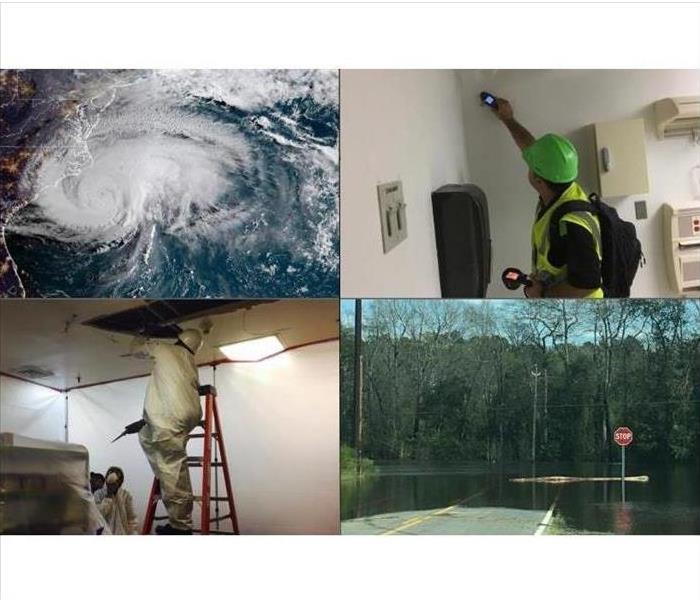 No job is too big, and no job is too small. SERVPRO of Desoto, Tate, & Tunica Counties is always here to help! 662-349-6500.
No job is too big, and no job is too small. SERVPRO of Desoto, Tate, & Tunica Counties is always here to help! 662-349-6500.
Last month, Hurricane Florence brought two feet of water to the two states in just three days. Hurricane Florence rained more in one hour over the city than the area typically gets during the entire month of September. This record amount of rainfall left countless homes severely damaged or completely washed away.
After the rain stopped, everyone got to work picking up the pieces of their homes and businesses to begin getting things back to normal. During this time, local SERVPRO teams were so over-encumbered they called in other SERVPRO teams from all over the country to aid in clean-up and restoration. SERVPRO of Desoto, Tate, & Tunica Counties was one of hundreds of teams who responded to the call.
We loaded up SERVPRO trucks and vans and made our way through to the Carolinas. Over the weeks that followed, we helped many families get their lives back to normal by drying hardwood floors, tearing out carpets, and ripping out soggy drywall.
SERVPRO of Desoto, Tate, & Tunica Counties is proud to be part of the Storm Response Team Caring for the Carolinas. Faster to any size disaster, SERVPRO of Tupelo will make it "Like it never even happened."
Give us a call at 662-349-6500. We are always here to help
Hurricane Season 2018 is Here
9/11/2018 (Permalink)
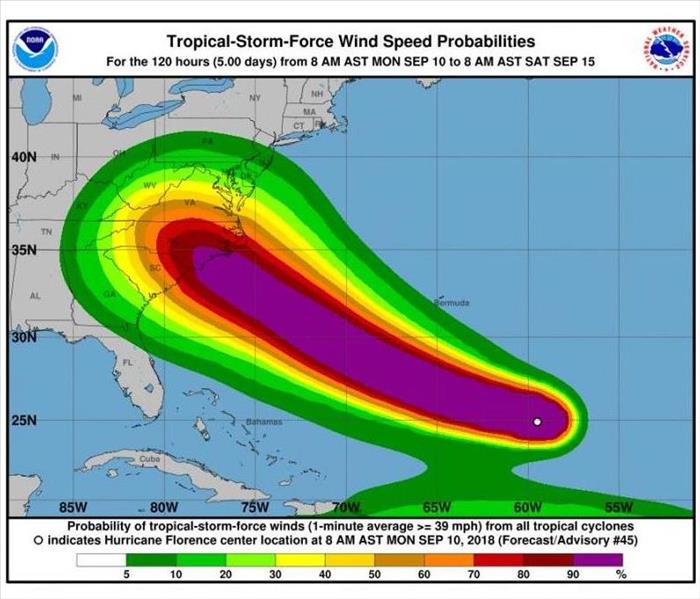 SERVPRO is always here to help!
SERVPRO is always here to help!
Weather models have flipped the switch': Hurricane season coming to life in the Atlantic
The sleeping giant may be about to awaken.
Hurricane activity in the Atlantic Ocean, Caribbean Sea and Gulf of Mexico is forecast to ramp up over the next couple of weeks. "Weather models have flipped the switch on the Atlantic hurricane season and see multiple areas of development possible starting mainly this weekend," weather.us meteorologist Ryan Maue said.
One storm could spin up in the Caribbean over the next couple of days and potentially affect Florida over the Labor Day weekend. Looking further ahead, "there is the potential for two or three tropical features spinning over the Atlantic by the second weekend in September," AccuWeather meteorologist Dan Kottlowski said.
The next tropical storm or hurricane in the Atlantic basin will be called Florence.
One of the reasons for the predicted uptick in activity is that wind shear, which tends to rip apart developing hurricanes, appears to be decreasing. "There are signs now that wind shear may drop over a significant part of the Atlantic basin over the next couple of weeks," according to AccuWeather meteorologist Bernie Rayno.
However, it's still too early to predict exactly where or when any storm might form or whether a storm will affect land areas.
SERVPRO nationwide is ready for whatever size disaster.
When the STORM Rolls Out, We Roll In
8/13/2018 (Permalink)
 SERVPRO can handle everything from emergency board up to mitigation to post construction. Call us today at 662-349-6500.
SERVPRO can handle everything from emergency board up to mitigation to post construction. Call us today at 662-349-6500.
Unexpected emergencies like severe weather call for immediate action. SERVPRO of Tupelo knows immediate reaction to the disaster is important to helping you get your life back to normal.
Utilizing our 1-4-8 Service Response Guidelines we strive to:
- Contact you within 1 hour from notice of loss to arrange for your service.
- Be-on-site to begin mitigation services within 4 hours of notification.
- Provide verbal briefing of scope to you within 8 business hour of on-site arrival.
Exceptions to our 1-4-8 Service Response times may apply under certain conditions, such as a local catastrophic event or storm situation.
We also perform pack-out services, which is removing salvageable personal property from the affected area for off-site cleaning and storage.
If you have storm damage to your home or property, call us today 662-395-6500. Timely mitigation is the key to minimize secondary damages caused by severe storms. We are also a one stop shop. We can handle everything from tarping and board ups to all of your post construction needs as well.
What To Do After A Hail Storm
7/9/2018 (Permalink)
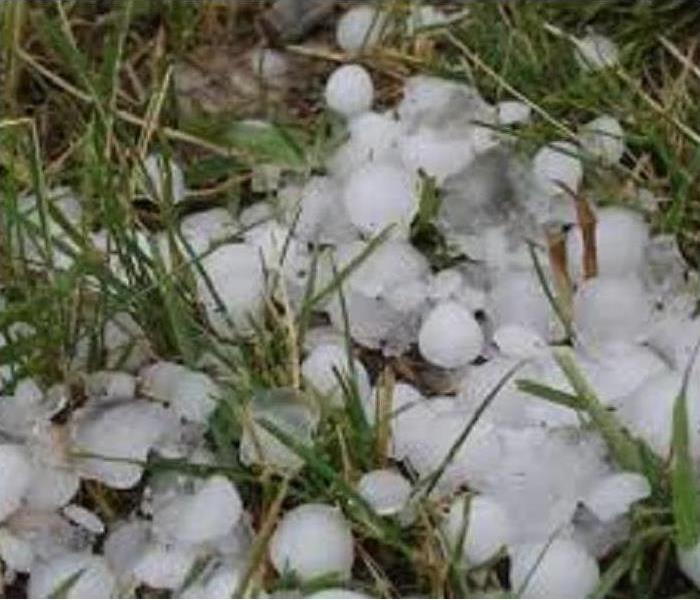 Call the Professionals at SERVPRO of Desoto, Tate, & Tunica Counties at 662-349-6500.
Call the Professionals at SERVPRO of Desoto, Tate, & Tunica Counties at 662-349-6500.
UNDERSTANDING HAIL DAMAGE: WHAT TO SURVEY AFTER A STORM
Do you have hail damage? It is not that easy a question to answer. If your building has asphalt shingles or a metal roof, you may see dents. But, on a built-up (tar & gravel) roof, you might see few to no visible signs of damage.
When do you need professional help? Three Helpful Indicators:
Hail comes in many sizes and densities, so it can be difficult to know when you actually need to be concerned about damage. Whether you’re staring at pea-sized hail on the ground or golf-ball size hail, here are some signs that indicate it would be a good idea to at least talk to a professional:
- Damaged vehicles—If the roofs of nearby cars were dented, then there’s a good chance your building also sustained hail damage.
- Damaged siding, downspouts or windows—If you are unable to safely inspect your roof, hail damage to other parts of your building, such as dented downspouts or siding, can be a good indicator you may need to take action.
- Work on neighboring properties—If a neighboring building sustained hail damage and is being repaired, it’s a sign you should more closely inspect your roof and building.
Summer Storms
6/13/2018 (Permalink)
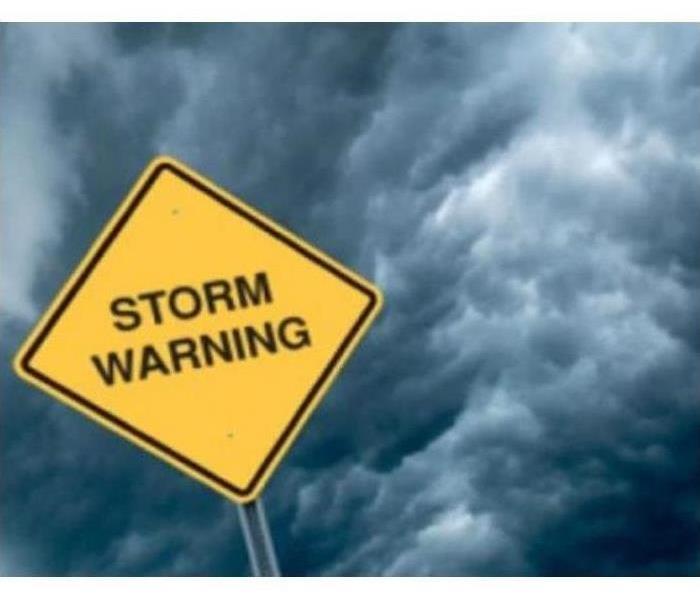 SERVPRO of Desoto, Tate, & Tunica Counties is always here to help, no matter the size of the storm!
SERVPRO of Desoto, Tate, & Tunica Counties is always here to help, no matter the size of the storm!
In some areas of the country, rain is almost a daily occurrence during summertime, and summer storm damages are something to be prepared for. Flooding can be a summer storm hazard, and that can be inconvenient and even dangerous. Possessions can be ruined, and the structures of homes and businesses can be negatively affected. A professional water damage restoration company can be a vital resource during such times; such companies are able to complete all necessary repairs in a timely and efficient manner.
While storms can’t be predicted much of the time,educating yourself on the most common areas vulnerable to storm damages will help you be prepared to handle such an event. Some areas of your home or business are going to be more apt to experience damage than others during storms, such as low-lying areas like basements and cellars which can be flooded.
Here is a list of the three most common areas that suffer from summer storm damages:
Basements and cellars, the lowest parts of a house or building, need to be watched during wet weather since they have a number of easy entry points for water. If there is heavy rainfall during inclement weather, or if the building is near a body of water such as a lake or river, they are going to be in danger. Keep an eye open for cracks in the foundation, ceiling, and walls of these areas!
- ATTICS, ROOFS, AND GUTTERS
A damaged roof, either from weather or fire, is susceptible to water damage, and the areas underneath it will suffer. A small leak can turn into a big problem before you know it. If rain gutters have not been properly maintained, you may experience some problems stemming from standing water - even indoors.
- WINDOWS, DOORS, AND ENTRYWAYS
Keep an eye on your doors and windows. If they are not properly sealed against wet conditions, you will know it right away. Entryways are also a potential problem area; make sure they are free of standing water and debris so that people don’t get hurt.
Our team of professionals here at SERVPRO of Desoto, Tate, & Tunica Counties are experienced in repairs and cleanup from damages caused by water and fire. You can call us at 662-349-6500. We are always here to help!
When Lightning Strikes
6/13/2018 (Permalink)
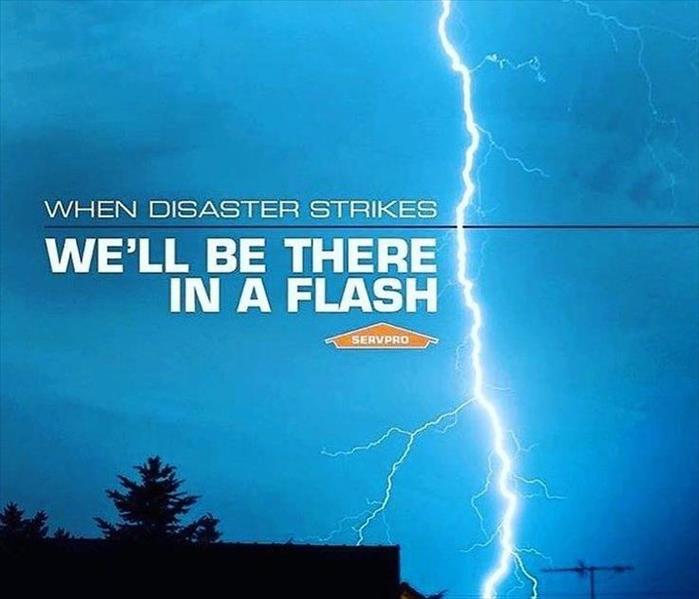 If your home is affected by a lightning storm, please call the professionals at SERVPRO of Desoto, Tate, & Tunica Counties at 662-349-6500
If your home is affected by a lightning storm, please call the professionals at SERVPRO of Desoto, Tate, & Tunica Counties at 662-349-6500
Each year thousands of homes and other properties are destroyed or damaged by lightning strikes.
The first step to protecting your home is contacting a professional who is qualified to design and install a certified lightning protection system. It will be designed to control or force the discharge onto a specified path, thereby eliminating the chance of fire or explosion within non-conductive parts of the house such as those made of wood, brick, tile, etc. A lightning protection system is not intended to prevent a strike. Its purpose is to provide a safe path on which the current can be safely directed to the ground.
A typical lightning protection system
A complete system is made up of the following components:
- Air terminals:Also referred to as lightning rods, these inconspicuous copper or aluminum rods are vertically mounted on the roof at regular intervals. The air terminals serve as strike receptors, designed to intercept the lightning strike.
- Main conductors:Constructed of aluminum or copper, these braided cables connect the air terminals to the other system components and the grounds.
- Grounds:A minimum of two ground rods, driven at least 10 feet deep in the earth are required for all structures. The ground terminations direct the dangerous current into the ground, to eliminate the chance of injury or damage to the structure.
- Bonds:Bonding joins metallic bodies (roof components) and grounded building systems to the main conductor to ensure conductivity and prevent side flashing (lightning jumping between two objects).
- Surge arresters and suppressors:A surge is an increase in electrical current due to a lightning strike on or near a power line or utility service. Surge suppression is installed at the electrical panel(s) to prevent the entrance of over-voltages which can cause a fire. Arresters installed at electrical panels help protect heavy appliances and prevent fires at service panel entrances. Additional devices may be needed to protect other in-house electronics. Surge protection devices are typically installed in conjunction with a lightning protection system.
Tree protection: The Lightning Protection Institute recommends that any tree taller than a home or within 10 feet of the structure be equipped with a lightning protection system. Trees do not offer protection and many homeowners choose to have trees protected for their own value. An unprotected tree in close proximity to a structure can also create a side-flash hazard to the nearby home.
Always be Prepared!
4/25/2018 (Permalink)
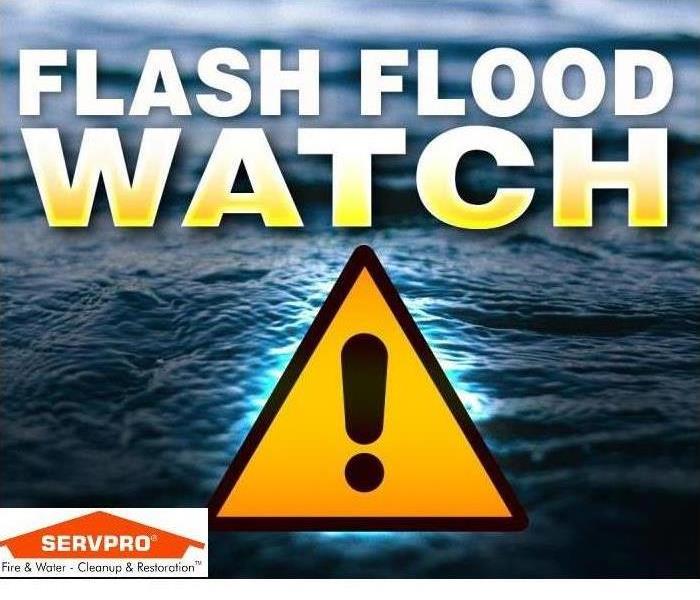 Call SERVPRO of Desoto, Tate, & Tunica Counties. No job is too big or too small. We are always here to help! 662-349-6500
Call SERVPRO of Desoto, Tate, & Tunica Counties. No job is too big or too small. We are always here to help! 662-349-6500
What is the difference between a Flood Watch and a Flood Warning issued by the National Weather Service?
- Flash Flood Warning: Take Action! A Flash Flood Warning is issued when a flash flood is imminent or occurring. If you are in a flood prone area move immediately to high ground. A flash flood is a sudden violent flood that can take from minutes to hours to develop. It is even possible to experience a flash flood in areas not immediately receiving rain.
- Flood Warning: Take Action! A Flood Warning is issued when the hazardous weather event is imminent or already happening. A Flood Warning is issued when flooding is imminent or occurring.
- Flood Watch: Be Prepared: A Flood Watch is issued when conditions are favorable for a specific hazardous weather event to occur. A Flood Watch is issued when conditions are favorable for flooding. It does not mean flooding will occur, but it is possible.
- Flood Advisory: Be Aware: An Flood Advisory is issued when a specific weather event that is forecast to occur may become a nuisance. A Flood Advisory is issued when flooding is not expected to be bad enough to issue a warning. However, it may cause significant inconvenience, and if caution is not exercised, it could lead to situations that may threaten life and/or property.
It's (Spring Cleaning) Time!
3/28/2018 (Permalink)
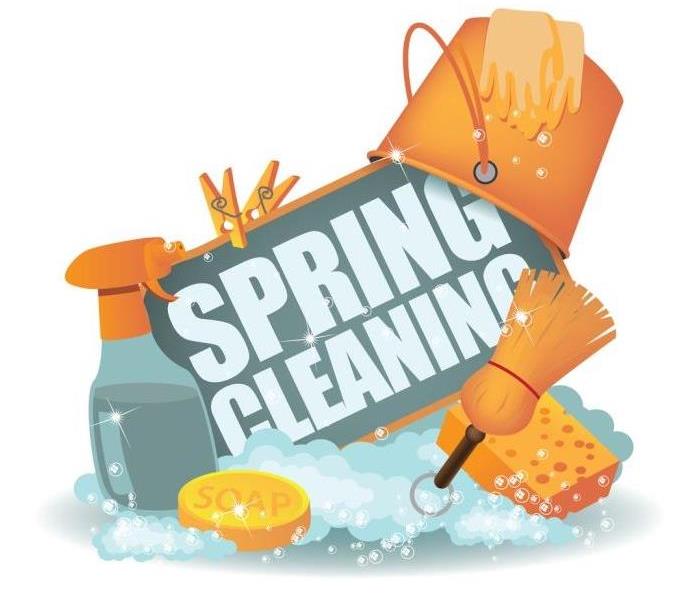 SERVPRO of Desoto, Tate, & Tunica Counties loves to clean! Call us for all of your Spring Cleaning needs! 662-349-6500.
SERVPRO of Desoto, Tate, & Tunica Counties loves to clean! Call us for all of your Spring Cleaning needs! 662-349-6500.
Make doormats welcoming!
Shake 'em, wash 'em, swat 'em with a broom. Give them the toughest cleaning they can take. They’re your front line against tracked-in dirt—so keep them clean enough to function at peak efficiency.
Clean carpets and upholstery
Fabrics that have absorbed a winter’s worth of dirt, body oil, and germs will need a deep cleaning to get them ready for another year of wear—and for that close inspection by your relaxing guests. When you’re shampooing carpets or cleaning upholstery with a rented carpet cleaner, practice first in an unobtrusive area to make sure you have the knack of the machine and that the treatment won’t discolor fabrics or cause dyes to run. Move furniture just slightly—not out of the room or against the wall, as the old rules dictated—and place the legs of each piece back on top of small wax paper squares after shampooing. The wax paper will protect your carpet and keep the furniture legs from getting wet as the carpet dries. Open the windows to speed the drying process, which can take a day or more. If you’re not the furniture-shifting and machine-renting type, use a professional carpet and upholstery cleaner.
Wash walls, cabinets, baseboards, and woodwork
The walls may not look as if they need a bath—dust and soot fall to the floor, right? Most of it does, but just enough clings to vertical surfaces to warrant a seasonal or pre-holiday bath. Use a sponge and hand dishwashing detergent, washing the surface in sections. A sponge mop makes it easier to reach higher spots. Use two buckets: one for dishwashing detergent solution and another for wringing your sponge. Dry the walls and woodwork with a clean cloth.
Clean ceiling fixtures
Remove dust and dirt from ceiling fans and air-conditioner vents with a cloth and a vacuum with a soft nozzle attachment.
Check your coils
You should clean the refrigerator’s condenser coil, usually found behind the toe grille, with a long-handled bottle brush and a vacuum cleaner with an attachment hose to remove dust and lint. Built-up dust can shut down the unit by causing it to overheat. To remove dust from coils attached to the hard-to-reach back side of the fridge, carefully pull the refrigerator out several feet (newer models roll on casters) and vacuum thoroughly; finish by sweeping or vacuuming the floor area you’ve revealed. Expect to rediscover coins, bottle caps, and twist ties that you and the cat knocked over the past year.
When Disaster Strikes, You Can Be Ruined or You Can Be READY!
3/28/2018 (Permalink)
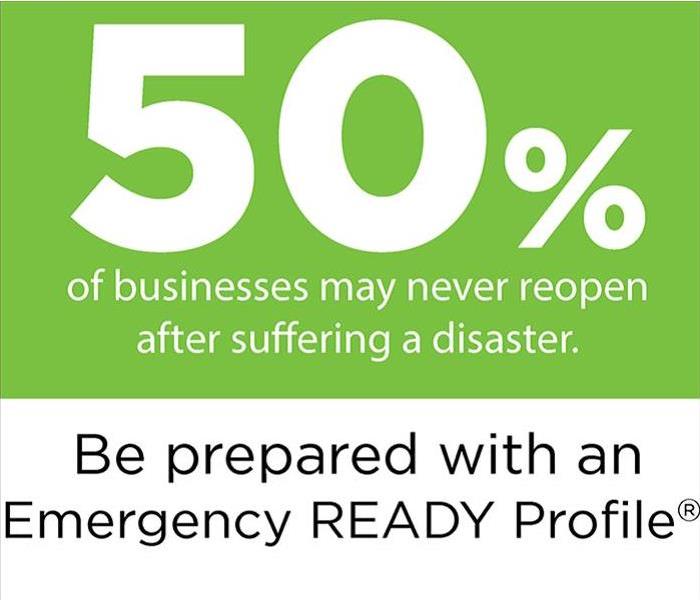 50% of business may never reopen after a disaster strikes. The professionals at SERVPRO of Destoto, Tate, & Tunica Counties are always here to help!
50% of business may never reopen after a disaster strikes. The professionals at SERVPRO of Destoto, Tate, & Tunica Counties are always here to help!
SERVPRO of Desoto, Tate, & Tunica Counties is committed to providing fire and water cleanup and restoration services to reduce business interruptions and recovery costs. SERVPRO can provide:- Over 40 years of experience as leading fire and water cleanup and restoration providers.
- A SERVPRO franchise nearby - more than 1,500 franchises servicing 48 states.
- More locations for faster responses.
- Quick response time to help ensure the damage is contained and the restoration process begins promptly.
- Large loss capabilities - no fire or water damage is too big.
As many as 50% of businesses close down following a disaster, according to the latest research. Of the businesses that survive, the overwhelming majority of them had a preparedness plan in place. Pre-planning can serve as an insurance policy aimed at peace of mind. And knowing you are "Ready for whatever happens" speaks trust to your clients and employees that in the event you business is affected by a disaster, they don't necessarily have to be.
By developing a SERVPRO Emergency Ready Profile for your business, you help to minimize business interruption by having an immediate plan of action. Know what to do, who to call and what to expect in advance is helpful in receiving timely mitigation and can help minimize the affects water and fire damage can have on your business.
Family Emergency Plan - Always Be Prepared
12/29/2017 (Permalink)
 Always be prepared. SERVPRO of Desoto, Tate, & Tunica Counties is here to help. 662-349-6500.
Always be prepared. SERVPRO of Desoto, Tate, & Tunica Counties is here to help. 662-349-6500.
An emergency can happen when we least expect it. It is important to prepare as much as possible for any situation. Having a family emergency plan is crucial to keeping your family safe during an imminent crisis. SERVPRO of Desoto, Tate, & Tunica Counties would like to share strategies you can use with your family in the event of a crisis to keep them prepared and safe.
Have a Designated Meeting Space
In the event of a fire or other disaster inside the home, it’s important to have a designated meeting space that is close to the property. If a fire happens, find somewhere safe that is close by for the family to meet.
Dealing with Natural Disasters
With the weather acting as unpredictable as it has been of late, it’s important to understand your town’s geography and climate and prepare for whatever weather affects it the most. In the case of a flood, don’t wait for the water to get to unsafe levels! Your family’s safety comes first, and it’s not worth risking staying in your home if it’s going to flood from the water. Take what little belongings you can and leave before the water gets too out of control.
Know Basic CPR
If one of your family members becomes injured, faints, or worse, it’s important to know basic CPR skills before paramedics can arrive. Make sure your whole family attends CPR classes; they’re affordable, hands-on, and can save a life! Keeping track of your loved ones’ medical history is important, too. If disaster strikes and a medical flare-up happens, you need to know what to do!
Disaster strikes when we least expect it to. We oftentimes live comfortable lives and forget that an emergency can strike at any time. Your family’s safety should be a top priority, and planning is the best way to ensure this. Communicate with your family, create contingency plans for disasters, and you’ll find yourself more prepared than you thought you were in the event of a disaster.
Be SERVPRO Ready!
12/27/2017 (Permalink)
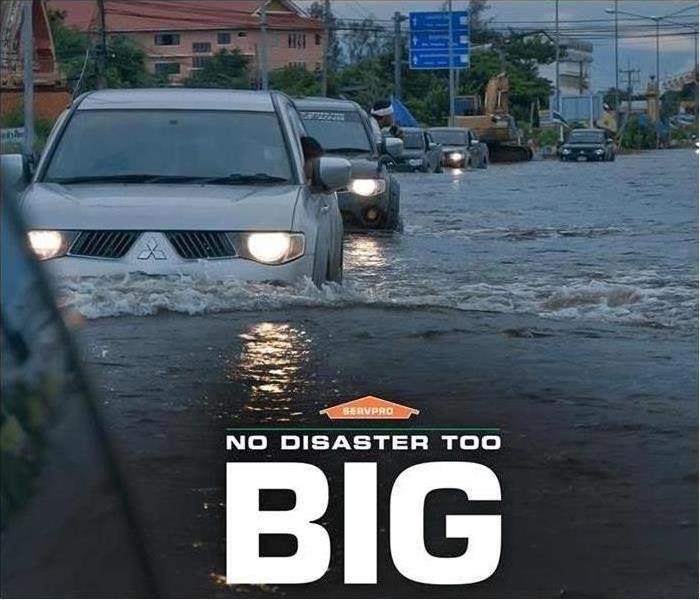 As many as 50% of businesses close for good following a disaster. Call SERVPRO of Desoto, Tate, & Tunica Counties at 662-349-6500. We are here to help
As many as 50% of businesses close for good following a disaster. Call SERVPRO of Desoto, Tate, & Tunica Counties at 662-349-6500. We are here to help
SERVPRO of Desoto, Tate & Tunica Counties is committed to providing fire and water cleanup and restoration services to reduce business interruptions and recovery costs. SERVPRO can provide:
- Over 40 years of experience as leading fire and water cleanup and restoration providers.
- A SERVPRO franchise nearby - more than 1,500 franchises servicing 48 states.
- More locations for faster responses.
- Quick response time to help ensure the damage is contained and the restoration process begins promptly.
- Large loss capabilities - no fire or water damage is too big.
As many as 50% of businesses close down following a disaster, according to the latest research. Of the businesses that survive, the overwhelming majority of them had a preparedness plan in place. Pre-planning can serve as an insurance policy aimed at peace of mind. And knowing you are "Ready for whatever happens" speaks trust to your clients and employees that in the event you business is affected by a disaster, they don't necessarily have to be.
By developing a SERVPRO Emergency Ready Profile for your business, you help to minimize business interruption by having an immediate plan of action. Know what to do, who to call and what to expect in advance is helpful in receiving timely mitigation and can help minimize the affects water and fire damage can have on your business.
Post Flood Essentials
10/24/2017 (Permalink)
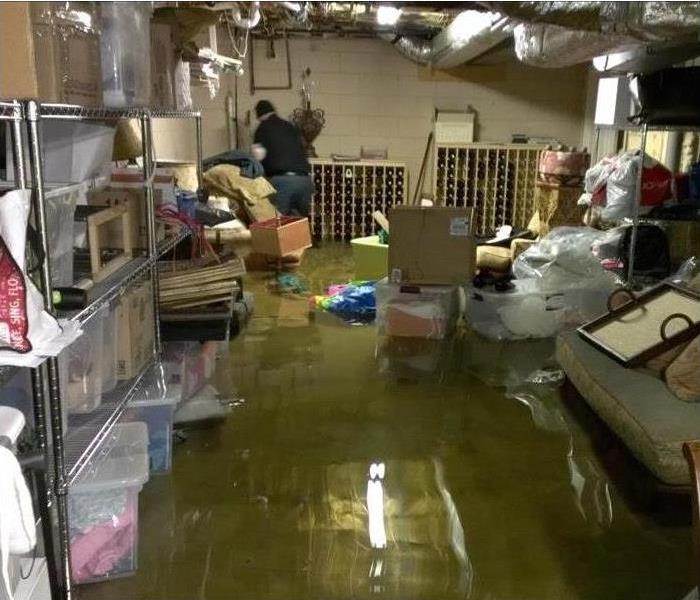 No flood is too big or too small for the professionals and SERVPRO of DeSoto, Tate & Tunica Counties. Call us today at 662-349-6500.
No flood is too big or too small for the professionals and SERVPRO of DeSoto, Tate & Tunica Counties. Call us today at 662-349-6500.
Nobody expected that the creek could rise that far, it never had before. Now, the house is a muddy mess of debris, water and extensive damage. For some people, moving would be the first thought that came to mind. However, others want to stay in their homes, repair the water damage and live on in the house that they love.
Flood damage is more than just the standing water left after the creek recedes. It's ruined carpets and furniture, wet plaster and more. Water in the home or business is just the start of the problems. Without proper clean-up and sanitization, further problems develop, mold can grow, floor damage can be permanent, and drywall can be ruined. It is imperative to immediately start the mitigation and restoration process to help limit the damage and mounting costs. A call to a professional water mitigation company should be the first step taken by a home owner after flooding occurs. SERVPRO DeSoto, Tate & Tunica Counties is here to help you 24/7/365 with any water damage and restoration issues.
Water cleanup begins with bringing in equipment to extract the water in the home. Pumps and specialized vacuums are used to suck up the water. Restoration is a process. Once the puddles have been cleared, the next step will begin. The water damage will be in the walls, floors and furnishings. Drying is imperative to help stop the damage and to prevent mold from growing.
Air movers, dehumidifiers and other specialized equipment will be brought in to help dry out the water in walls, and moisture from furnishings and floors. Thoroughly drying water in the home will save thousands of dollars worth of damage later.
Restoration from the devastation of flood damage is not an easy experience. A professional service should be called to handle and help facilitate the process so that it is done correctly. For instance, not many individuals would know that after the water in their business or home is dried, more steps are still necessary to properly complete the job. Sanitizing the surfaces, furnishings and anything else the water touched is essential to prevent any potential of mold growth.
Standing water can leave a foul odor. Professionals can remove the lingering odors left even after the water cleanup. Mitigation professionals are equipped with specialized fogging equipment and industrial air scrubbers to help remove the last traces of the water damage.
After the restoration process of water cleanup, drying, sanitizing and odor elimination, there is still one last step in the water damage mitigation process repairs. Water can damage walls, carpeting and flooring. Drywall may need to be replaced. Electrical outlets and wiring should be checked for damage. Water may have warped sub-flooring, damaged floor joists and wrecked major appliances. Time is money, so flood damage needs to be taken care of as quickly as possible. Quick, yet thorough mitigation, will get a business back up and running, or a family back if their home, after flood damage has occurred.
Storms, floods, and even appliance malfunctions (like a dishwasher overflow) can cause homes and businesses the headaches of having to deal with the water cleanup process. Nobody wants to go through it, but when it happens a person shouldn't go through it alone. Professionals who know how to deal with the devastation left behind are the best option for a quick, safe restoration. Since professional water damage restoration companies have the equipment and training to handle cleaning, drying and even rebuilding homes and businesses, they should be the first choice for mitigation.
After the Flood...Then What?
8/7/2017 (Permalink)
 No Storm damage is too big or too small for the professionals at SERVPRO of DeSoto, Tate, & Tunica Counties. Here to Help!
No Storm damage is too big or too small for the professionals at SERVPRO of DeSoto, Tate, & Tunica Counties. Here to Help!
Nobody expected that the creek could rise that far. It never had before. Now, the house is a muddy mess of debris, water and extensive damage. For some people, moving would be the first thought that came to mind. However, others want to stay in their homes, repair the water damage, and live on in the house they love.
Flood damage is more than just the standing water left after the creek recedes. It's ruined carpets and furniture, wet plaster and more. Water in the home or business is just the start of the problems. Without proper clean-up and sanitizing, mold can grow, floor damage can be permanent and drywall can be ruined. It is imperative to immediately start the restoration process to help limit the damage and mounting costs. A call to a professional water mitigation company should be the first step taken by a home owner after flooding occurs.
Water cleanup begins with bringing in equipment to extract the water in the home. Pumps and specialized vacuums are used to suck up the water. Restoration is a process. Once the puddles have been cleared, the next step will begin. The water damage will be in the walls, floors and furnishings. Drying is imperative to help stop the damage and to prevent mold from growing.
Fans, dehumidifiers and other equipment will be brought in to help dry out the water in walls and moisture from furnishings and floors. Thoroughly drying water in the home will save thousands of dollars worth of damage later.
Restoration from the devastation of flood damage is not an easy process. A professional service should be called to handle the process so that it is done correctly. For instance, not many individuals would know that after the water in their business is removed or the water in their home is dried, more steps are still necessary. Sanitizing the surfaces, furnishings and anything else the water touched should be done.
Water in the business or home could have left a foul odor. Professionals can remove the lingering odors left even after the water cleanup. Mitigation professionals know how to use fogging equipment and industrial air scrubbers to help remove the last traces of the water damage.
After the restoration process of water cleanup, drying, sanitizing and odor elimination, there is still one last step in the water damage mitigation process - repairs. Water in a business can damage walls, carpeting and flooring. Drywall may need to be replaced. Electrical outlets and wiring should be checked for damage. Water in a business may have warped sub-flooring, damaged floor joists and wrecked major appliances. Time is money, so flood damage needs to be taken care of as quickly as possible. Quick yet thorough mitigation will get a business back up and running after flood damage has occurred.
Storms, floods and even appliance malfunctions like a dishwasher overflow can cause homes and businesses the headaches of having to deal with the water cleanup process. Nobody wants to go through it, but when it happens a person shouldn't go through it alone. Professionals who know how to deal with the devastation left behind are the best option for a quick, safe restoration. Since professional water damage restoration companies have the equipment and training to handle cleaning, drying and even rebuilding homes and businesses, they should be the first choice for mitigation.
Sure, the damage is devastating and overwhelming. Of course, nobody wants to go through flooding and the after-effects. The reality is that these occurrences can and do happen every day. The good news is that there are people specifically trained to restore homes and businesses to their pre-flood conditions. Call SERVPRO of DeSoto, Tate, & Tunica COunties today at 662-349-6500.
SERVPRO Storm Response - Ready For Whatever Happens
6/22/2017 (Permalink)
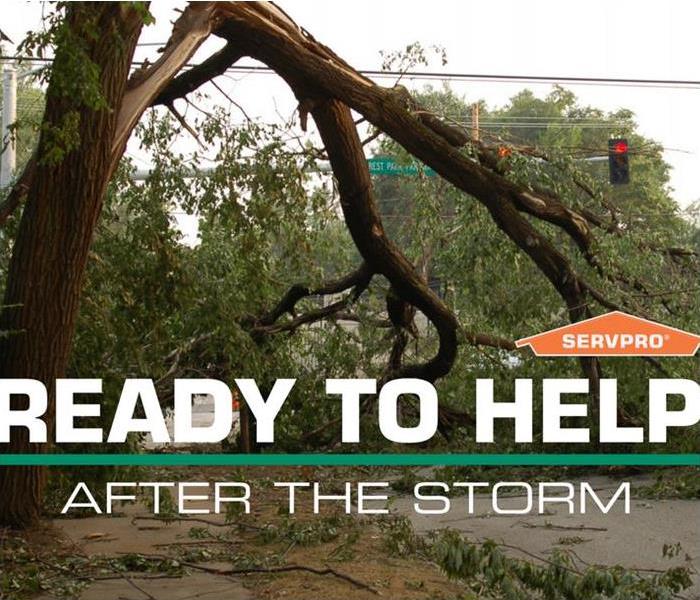 SERVPRO of DeSoto, Tate, & Tunica Counties is "Here to Help", especially after the storm. Call us today at 662-349-6500.
SERVPRO of DeSoto, Tate, & Tunica Counties is "Here to Help", especially after the storm. Call us today at 662-349-6500.
Every year, all over the country, catastrophic natural disasters wreak havoc on communities large and small.
Whether its turbulent blizzards, or torrid flooding, the effects of these colossal events can be felt across the nation.
In the midst of the chaos and stress caused by these happenings, it is easy for business and home owners to feel overwhelmed and lost.
SERVPRO strives to put our customers at ease, guiding them and supporting them through the STORM emergency process while providing education and knowledge on how to best navigate the situation.
From the initial damage assessment, to communicating with your insurance adjuster, to final billing and processing, SERVPRO supports our clients by providing superior customer service.
SERVPRO happily responds to local and outside STORM events. Nationwide, SERVPRO franchises mobilize and act fast, traveling cross country to assist in disaster clean up in communities across the US and Canada.
SERVPRO works in conjunction with all insurance companies, and is part of the Preferred Service Provider program for many nationally recognized insurance organizations.
For our self-pay customers, SERVPRO offers reasonable, competitive pricing and payment options. We understand that STORM cleanup is an unexpected expense, and strive to make reasonably priced restoration accessible to all our customers.
So in the event that your home or business is involved in a STORM, you can rely on SERVPRO to turn a stressful situation into a manageable, professional experience.
Call SERVPRO of DeSoto, Tate, & Tunica Counties today, no matter how big or small your water or fire damage may be. 662-349-6500. We are available 24 hours a day, 7 days a week.
Can My Carpet Be Saved After a Flood?
6/14/2017 (Permalink)
 No water damage is too big or too small for the professionals at SERVPRO of DeSoto, Tate, & Tunica Counties. Call us today at 662-349-6500.
No water damage is too big or too small for the professionals at SERVPRO of DeSoto, Tate, & Tunica Counties. Call us today at 662-349-6500.
After a flood, many homeowners and property managers wonder if their carpet and pad can be saved. The answer is, it depends. Factors such as the age and quality of the carpet and pad, as well as the type of installation used, have to be taken into consideration. However, the type of floodwater that caused the damage is most important when determining whether or not carpet and padding can be salvaged.
There are 3 floodwater categories that determine whether the carpet and padding can be restored to their pre-disaster condition:
- Category 1 (clean water): non-contaminated water that may come from a broken pipe, sink, etc. After the water has been extracted, carpets and pads can be dried and restored in place.
- Category 2 (gray water): dirty water that has been released by sump pumps, washing machines, dishwashers, etc. The carpet can usually be restored if it has been wet for less than 48 hours. The pad is replaced in most cases.
- Category 3 (black water): water containing dangerous contaminants that may originate from sewage and toilet backflows as well as from floods caused by natural disasters. To protect your family’s health, carpets and pads should be removed, discarded and replaced.
Since every water damage situation is different, you cannot know for sure if or when your carpet and pad can be salvaged until you have a professional restoration company inspect the situation.
The faster you report the disaster, the lower the costs will be. If you’re dealing with a flooding problem, contact SERVPRO of DeSoto, Tate, & Tunica Counties today to speak to a Mitigation Specialist at 662-349-6500.
STORM Teams are Always Ready!
5/11/2017 (Permalink)
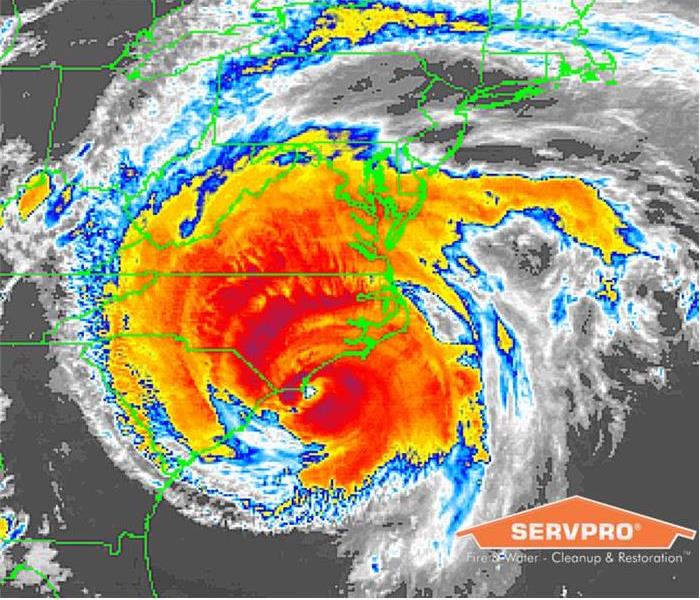 SERVPRO of DeSoto, Tate, & Tunica Counties is part of the Disaster Recovery Team. Always here to help!
SERVPRO of DeSoto, Tate, & Tunica Counties is part of the Disaster Recovery Team. Always here to help!
When a storm or disaster strikes, SERVPRO’s Disaster Recovery Team® is poised and “Ready for whatever happens.” With a network of over 1,600 Franchises, the SERVPRO® System strives to be faster to any size disaster. Strategically located throughout the United States allowing for a faster response time, SERVPRO’s Disaster Recovery Team®, is trained and equipped to handle the largest storms and highest flood waters.
Providing experience, additional manpower, equipment and other resources, the Disaster Recovery Team® assists your local SERVPRO® Franchise Professionals. SERVPRO’s Disaster Recovery Team® has responded to hundreds of disaster events, including those listed here.
In the aftermath of a disaster, there is only one objective, to help you make it “Like it never even happened.”
2014 Polar Vortex: Record low temperatures caused by a break in the North Pole’s polar vortex resulted in an unprecedented freezing event, spanning from east of the Rocky Mountains to as far south as Central Florida, effecting all or part of 39 states and 70% of the SERVPRO® Franchise system.
2013 Colorado Floods: Heavy rainfall, with amounts up to 17 inches in some areas, resulted in widespread flooding in Fort Collins, Boulder and surrounding Colorado mountain communities. The Disaster Recovery Team® responded with 109 crews from 48 Franchises to assist the local SERVPRO® Franchises in the emergency response.
2013 Alberta, Canada Floods: Heavy rainfall triggered flooding affecting more than 120,000 residents, and ultimately, the costliest disaster in Canadian history with damages estimated at C$5 billion, with C$1.7 billion in insurance damages.
2012 Hurricane Sandy: Affecting more than 20 states, Sandy left widespread damage and flooding from Florida stretching the entire eastern seaboard to Maine. The Disaster Recovery Team® placed nearly 1000 crews in affected areas, representing over 300 SERVPRO® Franchises from across the country. Teams traveled from as far as Arizona, California, Oregon and Washington.
2012 Hurricane Isaac: Hurricane Isaac caused flooding and damage across five states before weakening, including Florida, Louisiana, Mississippi, Alabama and Arkansas. Nearly 100 SERVPRO® Franchises were activated to assist in the cleanup and restoration efforts.
2011 Hurricane Irene/Tropical Storm Lee: With storm damage spanning from North Carolina to New England, activation of the Disaster Recovery Team®, combined with local resources, placed approximately 1,000 crews in affected areas.
2011 North Dakota Floods: SERVPRO® Franchise Professionals provided restoration services to more than 400 residents and businesses, including municipal buildings and the area hospital. The SERVPRO® System sent hundreds of crews to help.
Severe Weather Tips
4/7/2017 (Permalink)
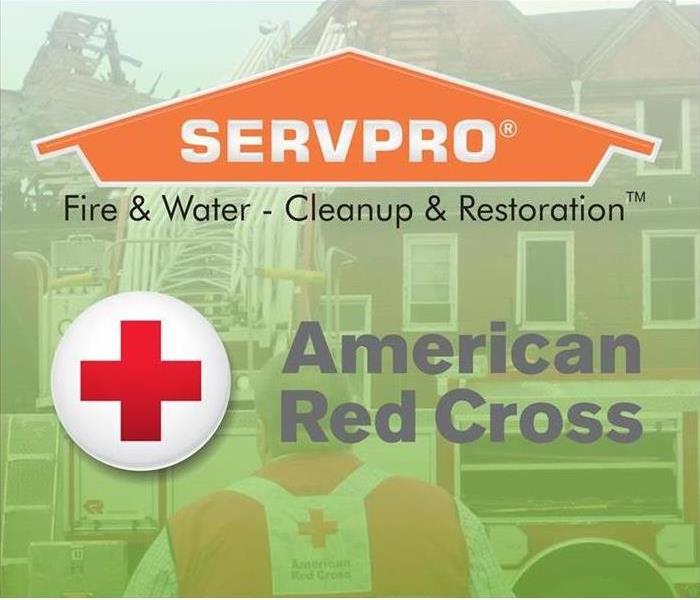 SERVPRO of DeSoto, Tate, & Tunica Counties is 24/7 no matter what size storm arises. Call us at 662-349-6500
SERVPRO of DeSoto, Tate, & Tunica Counties is 24/7 no matter what size storm arises. Call us at 662-349-6500
Since SERVPRO partners with the American Red Cross we love sharing their tips on different occasions.
Check out www.redcross.org for more information!
TORNADOES
Tornadoes can strike without warning and destroy a community in seconds. Before a tornado warning is issued for your area, here are some things you should do:
1. Know your community’s warning system.
2. Pick a place where family members can gather if a tornado is headed your way. It could be your basement or, if there is no basement, a center hallway, bathroom, or closet on the lowest floor. Keep this place uncluttered.
3. If you are in a high-rise building and don’t have enough time to go to the lowest floor, pick a place in a hallway in the center of the building.
4. Remove diseased and damaged limbs from trees.
5. Move or secure lawn furniture, trash cans, hanging plants or anything else that can be picked up by the wind and become a projectile.
THUNDERSTORM SAFETY STEPS Thunderstorms injure an average of 300 people every year, and cause about 80 fatalities. Here are the top thunderstorm safety steps you should follow:
1. If you can hear thunder, you are close enough to the storm to be struck by lightning. Go to safe shelter immediately.
2. As the storm approaches, take shelter in a building.
3. If you are driving, pull off the roadway and park. Stay in the car with the windows closed and turn on the emergency flashers. Avoid touching metal or other surfaces that conduct electricity in and outside of the vehicle.
4. If you are inside, unplug appliances and avoid using the telephone or any electrical appliances. Avoid taking a bath or shower, or running water for any other purpose.
5. If you are caught outside and cannot reach a safe building, avoid high ground, water, tall, isolated trees and metal objects such as fences or bleachers. Picnic shelters, dugouts and sheds are not safe.
FLOODING Heavy rains could fill rivers and streams, bringing flooding to the area. If your neighborhood is threatened with the possibility of flooding, here are some things you should do:
1. Be prepared to evacuate at a moment’s notice. When a flood or flash flood warning is issued for your area, head for higher ground and stay there.
2. Stay away from floodwaters.
3. If you come upon a flooded road while driving, turn around and go another way. If you are caught on a flooded road and waters are rising rapidly around you, get out of the car quickly and move to higher ground. Most cars can be swept away by less than two feet of moving water.
4. Keep children out of the water.
5. Be especially cautious at night when it is harder to recognize flood danger.
Download the free Red Cross Emergency App to receive emergency alerts and information about what to do in case of tornadoes, flooding and other disasters, as well as locations of shelters. The App also includes emergency first aid information and a Family Safe feature which allows people to instantly see if loved ones are okay. The free Emergency App is available in app stores by searching for the American Red Cross or going to redcross.org/apps.
Disaster Preparedness - What You Can Do
10/24/2016 (Permalink)
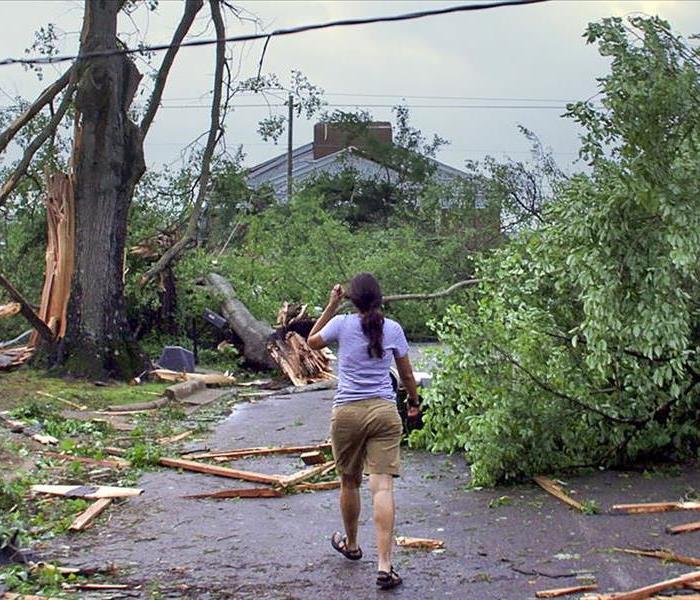 No storm is too big or too small for Servpro of DTT
No storm is too big or too small for Servpro of DTT
In order to be fully prepared, you should have all pertinent and proper information in a written plan for east retrieval. Some key questions to consider when creating a person preparedness plan include:
- Do you have an escape or evacuation route in place?
- Do you have a designated meeting place in case of separation?
- Does everyone have a list of contact information including family members out of state who can serve as a point of contact?
- Do you have a disaster supply kit with necessary supplies?
- Do you have a first aid kit that includes necessary prescription medicines, over-the-counter medicines and basic medical supplies?
- Do you have enough non-perishable food and bottled water?
- Do you have access to important family documents, including insurance policies, bank, credit card, and loan information and family records such as birth certificates and social security cards?
- Do you have an inventory of valuable household goods?
A well-equipped disaster supply kit should include, but is not limited to, the following,
- Water - a large enough supply to provide each person with 1 gallon daily for drinking and sanitation.
- Food - enough to last 3-7 days. Food needs to be non-perishable or canned food. You will also want to include a non-electric can opener, paper plates, and plastic utensils.
- Bedding including sheets, blankets, and pillows.
- Clothing - remember it may be warm, however, you may be working and cleaning and may prefer pants or long sleeves to protect your skin. You will also need sturdy, closed toe, non-slip shoes if available.
- First aid kit including antiseptics or sanitizers and bandages, over-the-counter and prescription medications.
- Extra flashlights and batteries. Oil lanterns also provide a good source of light, if available.
- Toiletries including toilet paper and hygiene items. Hand sanitizers are also good to have on hand.
- Battery-operated radio with extra batteries so you can listen to weather service announcements.
- Cash - you will want some cash and small bills on hand as banks may not be open.
- Emergency phone numbers and contact information including insurance agent and family contacts.
- Tools, tarps, plastic sheets, trash bags, duct tape, etc. to help make minor repairs.
- Important documents should be kept in a waterproof bag or plastic sealed container and should include insurance, medical and family records, birth certificates, social security cards, bank account information and a complete home inventory analysis.
- Gas - fill you car's tank ahead of time if time permits. You may also want to fill plastic gasoline-approved containers with gas to store.
- Pet care items including food, leash and a carrier or cage.
Don't wait until it is too late; prepare not to help protect your family in an emergency or disaster situation.
Call SERVPRO of Desoto, Tate, and Tunica Counties today to help us prepare your family at 662-349-6500.
When Disaster Strikes, You Can be Ruined or You Can BE READY!
10/17/2016 (Permalink)
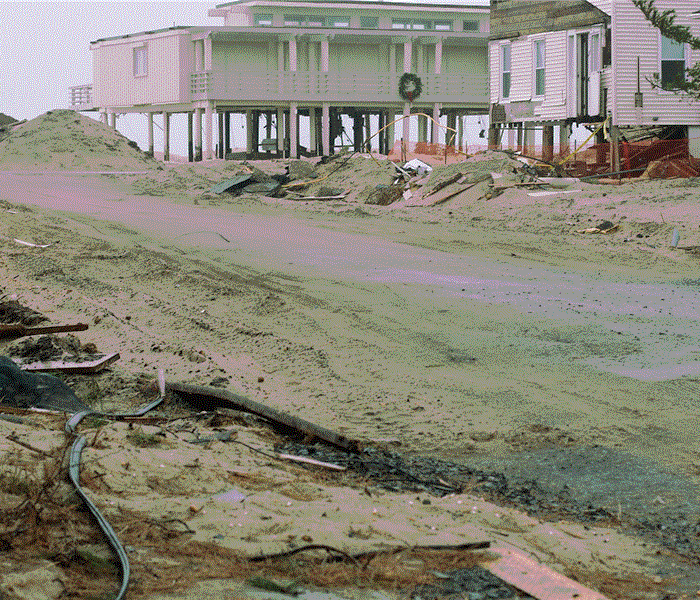 50% of businesses may never reopen after suffering a disaster...but SERVPRO of DTT is here to help!
50% of businesses may never reopen after suffering a disaster...but SERVPRO of DTT is here to help!
SERVPRO of DTT is committed to providing fire and water cleanup and restoration services to reduce business interruptions and recovery costs. SERVPRO can provide:
- Over 40 years of experience as leading fire and water cleanup and restoration providers.
- A SERVPRO franchise nearby - more than 1,500 franchises servicing 48 states.
- More locations for faster responses.
- Quick response time to help ensure the damage is contained and the restoration process begins promptly.
- Large loss capabilities - no fire or water damage is too big.
As many as 50% of businesses close down following a disaster, according to the latest research. Of the businesses that survive, the overwhelming majority of them had a preparedness plan in place. Pre-planning can serve as an insurance policy aimed at peace of mind. And knowing you are "Ready for whatever happens" speaks trust to your clients and employees that in the event you business is affected by a disaster, they don't necessarily have to be.
By developing a SERVPRO Emergency Ready Profile for your business, you help to minimize business interruption by having an immediate plan of action. Know what to do, who to call and what to expect in advance is helpful in receiving timely mitigation and can help minimize the affects water and fire damage can have on your business.
Floods Strike Everywhere - Even Southaven, MS
8/5/2016 (Permalink)
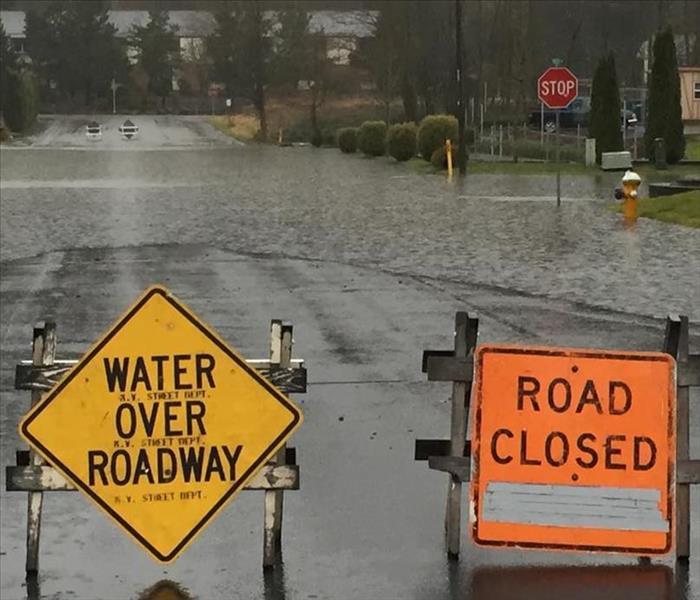 Please stay off flooded roads. Drivers often misjudge the depth of water on a road during a flood and can be swept away in a swiftly moving current.
Please stay off flooded roads. Drivers often misjudge the depth of water on a road during a flood and can be swept away in a swiftly moving current.
Floods rank as one of the most common widespread natural disasters in the United States. Whether you live near a coastline, along city streets, in the mountains, near a river, or even in the desert, there is a potential for suffereing flood damage. In fact, nearly 25% of last year's claims paid by the National Flood Insurance Program were for plicies in moderate to low-risk communites. According to NFIP, houses in the United States have a 26% chance of being damaged by a flood during the course of a 30 year mortgage, while businesses face similar risks by flooding. On average, floods cost $6 billion in annual losses in the U.S. The following are a few more little-known flood facts:
- Floods kill an average of 140 people per year in the U.S., making flooding the most deadly natural disaster.
- More than half of the fatalities during floods are auto related, often the result of drivers misjudging the depth of water on a road and being swept away in a swiftly moving current.
- The principle causes of lfoods in the eastern United States are hurricanes and storms.
- The principle causes of floods in the western United States are snowmelt and rainstorms.
- Underpasses can be some of the most dangerous places during a flash flood - especially at night, when it's difficult to see.
If flood damage to your home or business is not promptly mitigated, lingering moisture from floodwater may elevate the risk of mold growth. SERVPRO of Tupelo can properly remediate mold damage in your home or business. Even minor floods have the potential to cause major damage to the structure when not treated quickly and properly, and the cleanup is often overwhelming. SERVPRO of Tupelo is prepared to handle and size disaster and help make it "Like it never even happened."
Call SERVPRO of Tupelo at 662-690-6502 if you are a flood damage victim.
When The Storms Rolls Out...We Roll In.
6/20/2016 (Permalink)
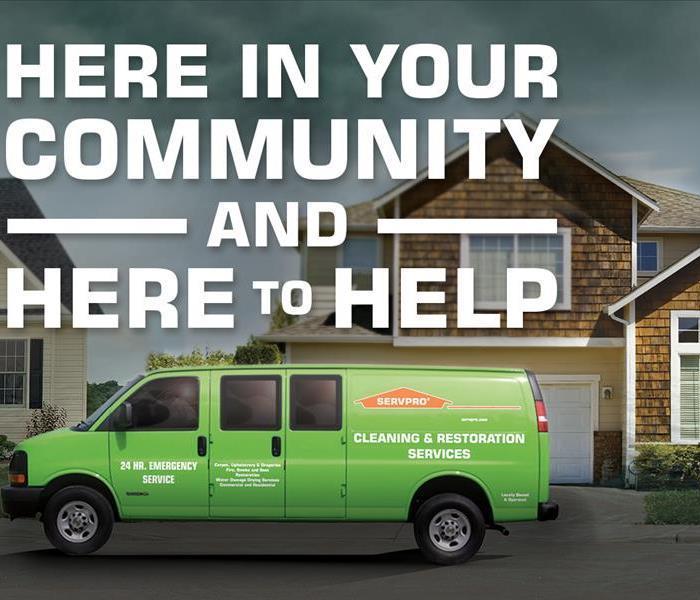 When the storm is the major event, you need more comprehensive restoration support. SERVPRO of DTT is "Ready for whatever happens."
When the storm is the major event, you need more comprehensive restoration support. SERVPRO of DTT is "Ready for whatever happens."
Catastrophic Storm and Major Event Response
The SERVPRO Disaster Recovery Team can provide help whether you're dealing with a tornado, hurricane, blizzard or flood. The SERVPRO System has a network of strategically positioned storm teams on standby should a disaster strike near you. Available 24 hours a day and 365 days a year, we are prepared for the unpredictable.
With the ability to mobilize local command centers, along with the resources of more than 1,650 Franchises nationwide, no disaster is too big. Recent mobilizations of the Catastrophic Storm Response Teams include:
- 2014 Polar Vortex
- 2012 Sandy
- 2010 Nashville floods
- 2008 Ike
- 2007 Chicago floods
- 2007 Ohio floods
- 2007 California wildfires
- 2005 Katrina/Wilma/Rita
Please call SERVPRO of DeSoto, Tate, & Tunica Counties today at (662) 349-6500 for any size storm damage.
SERVPRO of DeSoto, Tate, and Tunica Counties is Faster to Any Size Disaster
6/17/2016 (Permalink)
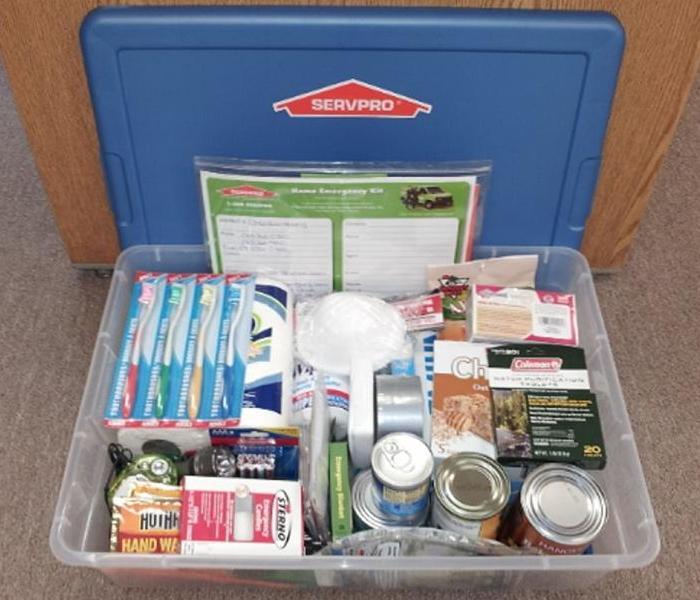 Sample of an Emergency Service Kit
Sample of an Emergency Service Kit
Unexpected emergencies like severe weather call for immediate action. SERVPRO of DTT knows immediate reaction to the disaster is important to helping you get our life back to normal.
We utilize a 1-4-8 Service Response Guideline and strive to:
- Contact you within 1 hour from notice of loss to arrange for service.
- Be on-site to begin mitigatiion services within 4 hours of notification.
- Provide a verbal briefing of scope to you within 8 business hours of on-site arrival.
SERVPRO of DTT also provides pack-out services, which is removing salvageable personal property from the affected area for off-site cleaning and storage.
If you don't have an Emergency Supply Kit already, these are the items we recommend you have in your kit:
- Water (one gallon per person per day)
- Food (non-perishable 3-day supply)
- Manual can opener
- Battery operated radio
- Flashlight and extra batteries
- First aid kit
- Whistle to signal for help
- Clothing
- Dust masks or bandanas
- Plastic sheeting, garbage bags and duct tape
- Wrench or pliers to turn off utilities
- Local maps
- Hygiene items
- Important documents - copies of insurance policies, identification and bank account information
- Cash
- Fire extinguisher
- Matches in a waterproof container
Call SERVPRO of DeSoto, Tate, and Tunica Counties today for any size disaster at (662) 349-6500.
When storms hit Southaven, MS SERVPRO is ready!
5/2/2016 (Permalink)
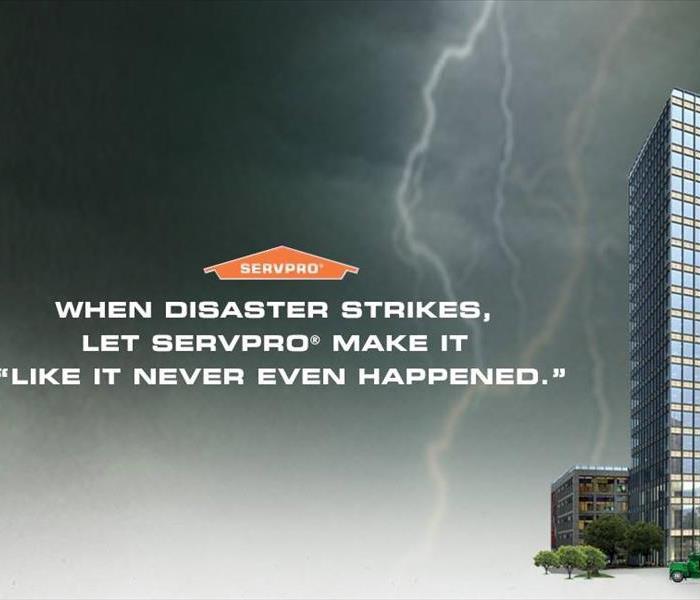 SERVPRO of Desoto, Tate, & Tunica Counties is equipped for all size storm damages.
SERVPRO of Desoto, Tate, & Tunica Counties is equipped for all size storm damages.
SERVPRO of Desoto, Tate, & Tunica Counties specialize in storm and flood damage restoration. Our crews are highly trained and we use specialized equipment to restore your property to its pre-storm condition.
Since we are locally owned and operated, we are able to respond quicker with the right resources, which is extremely important. A fast response lessens the damage, limits further damage, and reduces restoration costs.
When storms hit Southaven, MS and surrounding towns we can scale our resources to handle a large storm or flooding disaster. We can access equipment and personnel from a network of 1,650 franchises across the country and elite Disaster Recovery Teams that are strategically located throughout the United States.
Have STORM or FLOOD DAMAGE? Call us today at (662) 349-6500!

 24/7 Emergency Service
24/7 Emergency Service



























